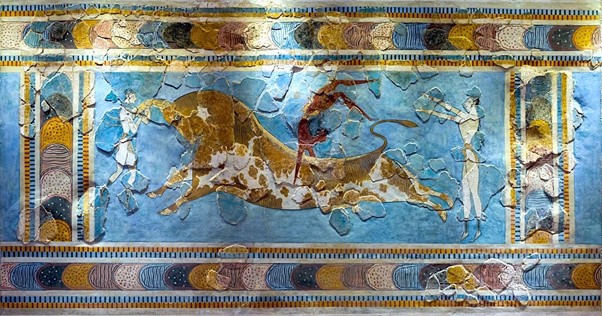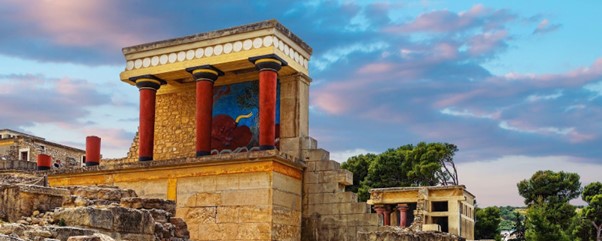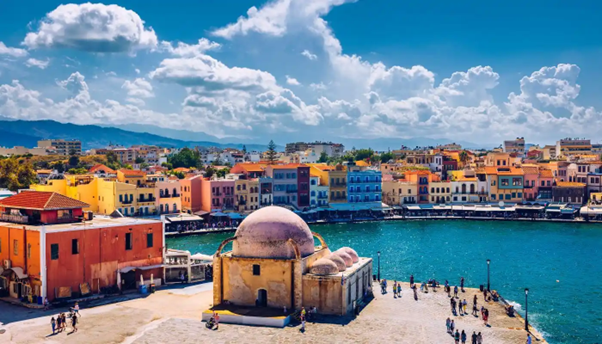Archaeological Museum of Heraklion
The Archaeological Museum of Heraklion houses the most important collection of Minoan artifacts, offering a deeper understanding of Knossos and Minoan culture. Among its most famous exhibits is the Phaistos Disc, a clay tablet with an undeciphered script from around 1600 BCE, and the Snake Goddess figurines, which symbolize fertility and religious power. The museum also features the original Bull-Leaping Fresco, Linear A and Linear B tablets, and exquisite examples of Minoan pottery, jewelry, and sculptures. These artifacts reveal the artistic, religious, and economic life of the Minoans, making the museum an essential complement to a visit to Knossos..

Knossos Palace
Knossos, the largest and most significant Minoan palace, was the political and ceremonial center of the Minoan civilization (~1900–1400 BCE). Located just 5 km south of Heraklion, it is closely tied to King Minos and the famous Labyrinth and Minotaur myth. Excavated and partially restored by Sir Arthur Evans, the palace is a vast complex with over 1,300 rooms, a central courtyard, and an advanced drainage system, showcasing the sophistication of Minoan architecture. The Throne Room, featuring the oldest throne in Europe, and the storage rooms with massive pithoi (clay jars) reflect the palace’s role in governance and trade. The site is also famous for its frescoes, including the Prince of the Lilies, the Bull-Leaping Fresco, and the Dolphins Fresco, which highlight Minoan artistry and culture. It is believed that bull-leaping rituals took place in the Central Court, symbolizing strength and religious devotion. Knossos provides a unique glimpse into Europe’s earliest advanced civilization and its connections to mythology.

Monastery Agia Triada
Located on the Akrotiri Peninsula, the Moni Agias Triados Ton Tzagkarolon (Holy Trinity Monastery) is one of the most important and beautiful monasteries in Crete. Built in the early 17th century by two Venetian-Cretan brothers of the Tzagarolos family, it showcases a blend of Venetian and Orthodox architecture, with an impressive façade and intricate stone carvings. The monastery played a crucial role in Cretan history, particularly during the Ottoman occupation, when it was an educational center and refuge. Today, it is still an active monastery, producing high-quality olive oil, wine, and honey, which visitors can purchase. Inside, the church features impressive frescoes and religious icons, while the small museum exhibits rare manuscripts and vestments. Surrounded by olive groves and vineyards, Moni Agias Triados offers a peaceful setting to experience Crete’s spiritual and cultural heritage.

Chania City Tour
The Old Town of Chania, one of the most picturesque and well-preserved Venetian towns in Greece, is a vibrant mix of Venetian, Ottoman, and Greek influences. Centered around the Venetian Harbor, it is lined with colorful buildings, historic mansions, and waterfront tavernas. The Egyptian Lighthouse, originally built by the Venetians in the 16th century and later reconstructed by the Egyptians, stands as a symbol of the city’s maritime heritage. The Firka Fortress, once a Venetian defensive structure, now houses the Maritime Museum of Crete. The town’s winding alleys reveal architectural gems such as the Hassan Pasha Mosque, a remnant of Ottoman rule, and the Arsenali, the Venetian shipyards. The Agora (Municipal Market), built in 1913, remains a lively spot to experience local flavors. The Jewish and Ottoman quarters, with their unique architecture, further showcase the city’s multicultural past. Chania’s Old Town is a living museum, offering a journey through centuries of history, from Minoan ruins to Venetian elegance and Ottoman charm.
